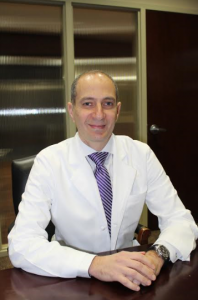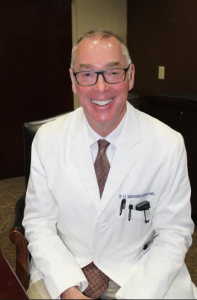
By Ameera Steward
The Birmingham Times
Heart disease is the No. 1 killer of men and women of most races in the United States, and area doctors are raising awareness and providing education about this condition throughout February, American Heart Month.
The first Friday of the month, Feb. 7, is designated National Wear Red Day, when people across the nation are encouraged to wear red to support women’s heart health. Here in Birmingham, physicians at Princeton Baptist Medical Center are taking extra steps to teach and empower people about cardiovascular, or heart, health.

“One of the most remarkable things is allowing the patient to be empowered,” said electrophysiologist Ibrahim Hanna, M.D. “How do you empower a patient? With knowledge. If you know about your condition, you are more likely to seek care early.” (An electrophysiologist is a doctor who serves as a heart electrician, dealing with the electrical activity of the heart and heart rhythm.)
Hanna and cardiologist Farrell Mendelsohn, M.D. say awareness is one way to disseminate knowledge about deadly heart disease.
Heart Disease
Heart disease can start long before a patient visits a doctor, Mendelsohn said, explaining that certain lifestyles choices—such as poor diet, lack of exercise, and smoking—can cause the condition.
“If people would adjust their lifestyles, we would have much less of an epidemic of heart disease in America,” he said. “We end up addressing this problem that a lot of times reflects the cumulative effects of these lifestyle issues.”
Those “cumulative effects” can lead to atherosclerosis, a build-up of plaque (fat, cholesterol, and other substances found in the blood) that can harden and narrow the arteries; hypertension, commonly called high blood pressure, in which the force of the blood against the artery walls is too high; and other conditions—all of which are interrelated, Mendelsohn said.
Lifestyle choices can lead to further heart damage, which can result in congestive heart failure that can cause problems with heart rhythm.
Genetic factors also contribute to heart disease, so those with a family history of the condition are at risk.
“A host of other issues can contribute to it, as well,” the heart specialist said. (TK, they’re both heart specialists, which one?) “High cholesterol levels, diabetes, high blood pressure, [and] smoking ultimately converge with a build-up of plaque.”
Once a person with a family history of heart disease reaches adulthood, they need to keep track of their blood pressure level and cholesterol values, as well as focus on making healthy lifestyle choices, Mendelsohn said.
He noted that the American Heart Association has implemented a public awareness campaign to encourage people to live healthier lifestyles—something that can start before a person has to see a physician.
The main symptoms of heart disease include chest discomfort, shortness of breath, and palpations, a sensation that the heart is racing or beating irregularly.
“We see patients all the time with devastating heart disease who have not had symptoms for years,” Mendelsohn said. “Hypertension, for example, is a terrible cardiovascular disease, and … 99 percent of patients don’t feel any symptoms related to their hypertension until it has actually damaged the heart or caused a stroke.”
Heart disease is treatable, and there are several basic ways to manage the condition, including medications and catheter-based treatments to clear blocked arteries.
“I tend to work mostly on blockage issues,” Mendelsohn said,

explaining that he clears blocked arteries with tools such as the balloon catheter (a long, thin tube with a balloon at the end that is inflated at the blockage site to flatten the plaque against the artery wall) and stent (a small, mesh tube made of medical-grade metal that is implanted in the artery to keep it open).
Surgical treatments—such as bypass surgery, a procedure that routes blood around artery blockages by transplanting a healthy blood vessel from the patient’s leg, arm or chest—are also available.
Arrhythmias
Another major cardiovascular issue is arrhythmia, or an irregular heartbeat. Atrial fibrillation, called AFib, is the most common type of heart arrhythmia. It can interrupt the normal flow of blood and kill if left untreated. The risk of AFib increases with age, but doctors are finding younger people who are at risk.
“When we think about AFib, we typically think about somebody who’s 65 years or older [because] the older you get, the more likely you are to have AFib,” electrophysiologist Hanna said. “So, when you see somebody who is 18 years old and has atrial fibrillation, that stops you in your tracks. You start sitting down and thinking about what is it that made this person have atrial fibrillation.”
As with many other cardiovascular diseases, AFib is multifactorial, meaning there can be several contributors to the problem, Hanna said. One of those is obesity, which can lead to sleep apnea and diabetes, both of which are risk factors for atrial fibrillation.
Obese people are more likely to have hypertension, as well. So, if people are becoming obese at a younger age, this could mean heart problems at a younger age.
Some patients are completely unaware of atrial fibrillation until they visit a doctor or a pharmacy and get their blood pressure checked, alerting the physician that the patient’s heart rate is fast or irregular.
“Many times, especially in the younger patient population, [AFib] manifests with palpitations, meaning people feel their heart beating fast and irregularly in their chest,” Hanna said.
Physicians and cardiologists can confirm that a patient is having a rhythm problem by doing an electrocardiogram (EKG), a procedure during which the patient is hooked to wires placed on the surface of the chest, and the electrical activity of the heart is recorded on a piece of paper. The EKG reading enables the physician to establish whether a rhythm problem exists.
Raising Awareness
In the United States, about 647,000 people (one person every 37 seconds) die from heart disease each year—that’s one in every four deaths. To further educate the public and raise awareness about cardiovascular health, Princeton Baptist Medical Center will host events throughout American Heart Month.
On Feb. 13, “Let’s Talk Senior: Heart Month,” a free seminar, will focus on what seniors and caregivers can do to about heart health. To learn more and register, visit the Princeton Baptist website’s “Events” page (www.princetonbaptistmedicalcenter.com/events).
Every Wednesday in February, free blood pressure checks will be available from 11 a.m. to noon. And the Princeton Baptist Medical Center cardiac team will be speaking at numerous engagements throughout the community at churches, assisted-living facilities, and other locations.
Updated on 2/10/2020 at 8:49 a.m. to correct date for the Heart Month seminar.




